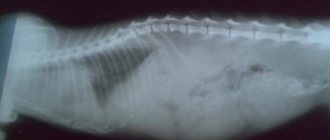A tumor in a cat’s abdomen is a neoplasm in the tissues of the body, which is in no way regulated by the animal or its owner. It may consist of cells that multiply on an ongoing basis, and then transfer their destructive properties to new cells. After studying this material, you will find out how long a cat with a tumor will live, what treatment modern veterinary medicine offers and other valuable information. It is imperative to study information one way or another related to this disease.
A tumor on a cat's stomach can be of different types.
It’s worth starting with the fact that all these unpleasant things are produced at the expense of the resources of the cat’s body and, according to the degree of aggressive impact on it, they differ into benign ones and those that pose a direct threat to life. Of course, a veterinarian should know all these types well in order to provide quality care, however, this information will also not hurt the ordinary owner and will be an excellent help in treating a terrible disease. Neoplasms that do not cause harm (benign) grow slowly, putting pressure on and expanding the tissues that surround them. These tumors do not grow and do not recur after removal.
A benign neoplasm does not deplete energy for the life of the body, but probably has a mechanical effect on it . For example, when a tumor begins to compress blood vessels, it can go, for example, to the heart or liver.
Malignant tumors, as a result of overly active division of cellular elements, grow rapidly. They are characterized by uncontrolled development. In other words, the tissue that surrounds the vessels is gradually destroyed. However, these tumors may remain small. They rarely grow to a large size, since the animal is quickly sent to the next world due to exhaustion and intoxication . In addition, malignant tumors are characterized by:
- Metastasis is a unique skill of cells. They spread throughout the body with blood, lymph and contact give rise to other similar tumors. Also, despite all the persistent treatment, a relapse of the disease is possible.
- Relapse is the re-formation of metastases, the re-growth of the tumor. Cats can develop both “good” and “bad” tumors.
The peak age for such diseases is 10-12 years. This is only according to official statistics. Swelling of the skin and subcutaneous tissue occurs quite often in cats. It has not yet been determined which cat breeds are most susceptible to tumors. The chest and area around the nipples are a favorite place for tumors to appear.
Why does deviation occur?
The development of the deviation is influenced by pathological and physiological factors. The first are dangerous to health and require the intervention of a veterinarian. The latter are natural, so they are easy to figure out on your own.
Hazardous factors
The presence of pathology is indicated when the abdominal muscles do not relax for more than a day, and the pet’s condition gradually worsens. This is due to the following reasons:
Constipation
. It occurs due to intestinal spasms, improper feeding, ingestion of a foreign object, helminthiasis and the accumulation of hair in the intestines during heavy shedding. Without prompt treatment, constipation can lead to intestinal obstruction and death.
Peritonitis
. The peritoneal mucosa becomes inflamed upon contact with gastric or intestinal contents. The penetration of foreign microflora is fraught with epithelial detachment and necrosis.
Poisoning
. Against the background of acute intoxication, painful spasms occur in the lower part of the stomach.
Abscess
. The danger of purulent formation in the abdominal organs lies in its rupture and subsequent blood poisoning.
Injury
. When internal organs are damaged, their contents leak into the peritoneum. The further reaction is similar to peritonitis.
Symptoms of a tumor on a cat's stomach
A caring owner has probably already wondered what the symptoms and signs of a tumor are in a cat. These signs are not highly specific and can easily be confused with another disease. The signs can be confused with poisoning or toxicosis (if it is a female) here they are: weakness, loss of appetite, loss of former playfulness, activity, the animal prefers to lie down and rest.
What diseases cause a lump?
The list is quite large:
- cancerous degeneration of breast tissue is the most terrible diagnosis, often with an unfavorable prognosis;
- lipoma, or wen, is a benign tumor prone to spreading;
- neoplasm of the skin: papilloma, fibroma, sarcoma, lymphangioma, etc.;
- lymphadenitis – inflammation of the lymph nodes;
- hernia (inguinal, umbilical, perineal) – protrusion of internal organs under the skin;
- mastitis;
- inflammation of the paraanal glands;
- a lump may appear after sterilization - this is also a hernia, but postoperative, resulting from a violation of the technique of applying internal sutures;
- skin diseases: furunculosis, folliculitis, carbuncle formation, abscess, phlegmon, etc.;
- a lump may appear due to an insect bite (wasp, bee, bumblebee, etc.);
- pellets - although tangles are unlikely to be confused with a lump, protrusion or tumor.
Important! If the formation under the skin tends to grow rapidly, while the number of nodules increases, they bleed or are painful, then this is not a good sign and a serious reason to undergo a full veterinary examination: biopsy, urine tests, ultrasound, x-ray, etc.
Treatment of tumors in cats on the abdomen
Over the past few years, significant progress has been made in the treatment of tumors, the type of treatment being selected depending on the type of tumor. After an examination by a veterinarian, the stage and type of tumor are first determined, and then a decision is made on chemotherapy. The treatment of the tumor must also be chosen by the doctor; the patient’s task is to follow the doctor’s prescription ; in general, there are several ways to treat tumors. For many neoplasms, chemotherapy is used as one of the most gentle treatment methods.
And thanks to the body’s ability to quickly absorb everything, chemotherapy is one of the fastest-acting methods of treatment. It is also possible that the doctor will prescribe radiation therapy, which is prescribed for such tumors and is not recommended for surgical intervention. Increasingly they are resorting to chemotherapy, as well as laser removal. It should be borne in mind that all kinds of drops and tinctures that promise an effect from the first use are most likely simply not effective, and in some cases are simply dangerous to the health of the animal.
Any treatment should be prescribed by a veterinarian, preferably one who has seen your animal more than once and can help with useful advice, as well as promptly come to your home if the cat suddenly becomes ill.
Why does a tumor appear on a cat's stomach?
Where a tumor can form can occur in the most unexpected place. A tumor in cats on the abdomen is the most common occurrence in pets over 10 years of age.
We can safely assume that the age of ten is the most dangerous in terms of all kinds of diseases, since it is then that various sores begin to form, which gently but unobtrusively indicate to the owner that he needs to be especially attentive to his furry pet and devote more time to its health. Remember that a tumor can form anywhere, even in a place where no one expected these tumors, for example, near the eye, in the ear.
Possible complications
You need to understand that ileus is a very dangerous condition. If left untreated, intestinal obstruction leads to disastrous consequences, including death. Feces, gases, and gastric juices accumulate in the intestines, as a result of which the blood supply is disrupted and necrosis (death of the intestinal walls) develops.
In addition, the body receives severe poisoning from decay products. This leads to the death of intestinal microflora and the development of putrefactive processes in the intestines.
The situation with partial ileus is somewhat simpler, when the intestinal lumen does not close completely, allowing gases and a small amount of feces to escape. However, this does not mean that treatment is not required.
How to prevent stomach tumors in cats
Many owners are sincerely concerned with the question, so how to prevent tumors? It is probably not possible to completely and 100% avoid this disease, especially if there is a genetic predisposition, and therefore everything possible can be done to alleviate this condition and make the cat’s life healthier and have a higher quality of life. To do this, you need to follow these simple and obvious steps:
- Regular and proper nutrition with specialized food, and not leftovers from the master’s table, which are not always healthy.
- A mandatory presence in the diet of vegetables and fruits seasoned with vegetable oil will help improve bowel movements.
- Then, it is recommended to remember that the food must be suitable, for example, according to the age and diseases that the furry friend may develop.
- Also, during the treatment period, it is very important to reduce the amount of junk food that can negatively affect the health of your four-legged friend. During cancer treatment, you need to follow a light and at the same time satisfying diet.
- Tumors in cats on the abdomen are a dangerous sign that shows that the owners mistreated their pet and created stressful conditions for it.
Of course, one trip to the veterinary center cannot cure this problem. You need to understand that you have a long and stubborn struggle ahead of you for the life of your pet. A veterinarian at home for tumors in cats on the stomach and other parts of the body is treated in different ways. But we must remember that a tumor cannot be cured in one visit to the veterinary center. Of course, you will need to visit the veterinarian frequently in order for your beloved creature to survive. However, if there are opportunities and time resources for this. But you need to examine the animal. What to do?
First of all, we strongly advise you to call a veterinarian at home. This service is very progressive and convenient for those owners who do not have enough time to visit a doctor on time. It is for such busy owners that there is a wonderful service like a doctor visiting your home. A tumor on the cat’s stomach requires special attention. Of course, you need to ask your veterinarian how long your furry pet will live. In many ways, the answer to this question also depends on the owners, because they are responsible for the pet.
Also, a visit from a veterinarian is great for those owners whose cat is quite weakened, which means that moving to a veterinary center can be fatal for it. In this case, leaving will not be a whim of the owner, but a severe necessity that will probably help save lives. If you want your pet to live as long as possible, do not neglect a visit to the doctor. However, doctors can help even with a tumor. And if you still have to visit a veterinary center for the procedure, then for an examination by a doctor you can use the service of calling a doctor to your home.
What to do if the terrible diagnosis of a tumor in cats is confirmed
Of course, there is no need to panic in the first place. Animals perfectly sense the mood of the owner who is nearby. Remain calm, which will certainly rub off on your pet. You also need to undergo a large number of tests and prepare yourself for a long fight against the disease. Veterinary doctors will do everything possible, and will also show the owner all the possibilities of modern medicine, which is capable of real miracles. It is quite possible that our drugs and skilled doctors will help cure such a terrible disease as a tumor. We are responsible for those we have tamed, and therefore it is not recommended to abandon a pet with a tumor to the mercy of fate. Having suspected something was wrong, it is also important to warn household members that they should be as attentive as possible to the animal and, if possible, not feed it harmful sausage or sausages, even if you want to support your cat and treat him with his favorite treat.
How long do cats with tumors live?
Unfortunately, no doctor in the world can give an accurate prognosis; it depends on many factors, as well as on how aggressively the tumor develops. It happens that, despite all the efforts made by the owner, the animal dies after a month. This could be due to a variety of factors. Starting from inappropriate treatment and ending with actively growing metastases. Try to regularly donate blood for analysis and carry out all the tests that the doctor prescribes for your pet. If he is scheduled for another study, this does not mean that they want to scam you out of money. The doctor wants to help the pet and does everything in his power. And without traditional research it is almost impossible to do this, because a visual inspection alone is not enough. We still need to examine the animal and do everything to ensure that the treatment matches the disease. Be attentive to your pets and take them for a preventive examination at YA-VET!
Diagnostics in a veterinary clinic
To make a diagnosis, the veterinarian examines the animal, studies the medical history, and also prescribes the necessary diagnostic measures. To determine the severity of intoxication, the cat's urine and blood are examined.
X-rays with a contrast agent and ultrasound are not advisable, since the studies do not give an accurate result.
The only complete and informative diagnostic method for blockage of the intestinal lumen is laparotomy.
Why you can’t give up when fighting a tumor on your cat’s stomach
A tumor in a cat’s stomach is one of the most mysterious diseases, which even today has not been fully studied by doctors, and therefore can disappear as suddenly as it appeared, or give multiple metastases, and then take root throughout the body. Remember that by stopping the fight against a tumor in a cat, you are thereby putting an end to the life of your pet; she can die at any moment due to your laziness and unwillingness to fight to the end. Veterinary doctors are doing everything in their power to save another life and a grateful animal jumped into your lap every day.
Clinical picture
Ileus in cats rarely manifests itself with significant symptoms (especially at an early stage). The owner should be wary if the pet refuses food, vomits, has a bloated stomach, and does not have stool for more than 2 days.
Symptoms of intestinal obstruction in cats have been shown to depend on the location of the blockage. When the small intestine is blocked by feces or foreign bodies, they are as follows:
- nausea;
- small discharge of liquid or formed feces (often with blood);
- uncontrollable vomiting.
If the disorder is caused by intussusception, then vomiting occurs simultaneously with diarrhea. The volume of feces is minimal; its consistency resembles redcurrant jelly.
The neoplasms initially partially block the intestines before closing their lumen. This leads to ulceration of its walls, so the stool contains blood (altered or fresh).
In all cases, cats exhibit the following signs of intestinal obstruction:
- deterioration of health;
- increased thirst;
- dyspnea;
- sunken eyes;
- decreased frequency of urination;
- decreased body temperature;
- abdominal pain.
When palpating the abdomen, hard formations can be detected.











